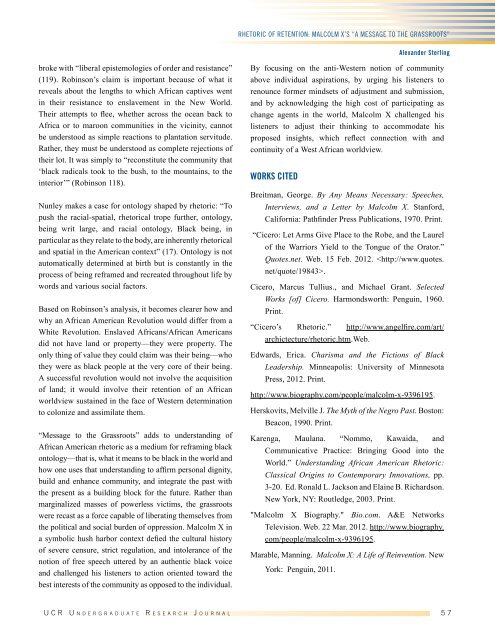Undergraduate Research Journal
Undergraduate Research Journal
Undergraduate Research Journal
You also want an ePaper? Increase the reach of your titles
YUMPU automatically turns print PDFs into web optimized ePapers that Google loves.
Rhetoric of Retention: Malcolm X’s “A Message to the Grassroots”<br />
Alexander Sterling<br />
broke with “liberal epistemologies of order and resistance”<br />
(119). Robinson’s claim is important because of what it<br />
reveals about the lengths to which African captives went<br />
in their resistance to enslavement in the New World.<br />
Their attempts to flee, whether across the ocean back to<br />
Africa or to maroon communities in the vicinity, cannot<br />
be understood as simple reactions to plantation servitude.<br />
Rather, they must be understood as complete rejections of<br />
their lot. It was simply to “reconstitute the community that<br />
‘black radicals took to the bush, to the mountains, to the<br />
interior’” (Robinson 118).<br />
Nunley makes a case for ontology shaped by rhetoric: “To<br />
push the racial-spatial, rhetorical trope further, ontology,<br />
being writ large, and racial ontology, Black being, in<br />
particular as they relate to the body, are inherently rhetorical<br />
and spatial in the American context” (17). Ontology is not<br />
automatically determined at birth but is constantly in the<br />
process of being reframed and recreated throughout life by<br />
words and various social factors.<br />
Based on Robinson’s analysis, it becomes clearer how and<br />
why an African American Revolution would differ from a<br />
White Revolution. Enslaved Africans/African Americans<br />
did not have land or property—they were property. The<br />
only thing of value they could claim was their being—who<br />
they were as black people at the very core of their being.<br />
A successful revolution would not involve the acquisition<br />
of land; it would involve their retention of an African<br />
worldview sustained in the face of Western determination<br />
to colonize and assimilate them.<br />
“Message to the Grassroots” adds to understanding of<br />
African American rhetoric as a medium for reframing black<br />
ontology—that is, what it means to be black in the world and<br />
how one uses that understanding to affirm personal dignity,<br />
build and enhance community, and integrate the past with<br />
the present as a building block for the future. Rather than<br />
marginalized masses of powerless victims, the grassroots<br />
were recast as a force capable of liberating themselves from<br />
the political and social burden of oppression. Malcolm X in<br />
a symbolic hush harbor context defied the cultural history<br />
of severe censure, strict regulation, and intolerance of the<br />
notion of free speech uttered by an authentic black voice<br />
and challenged his listeners to action oriented toward the<br />
best interests of the community as opposed to the individual.<br />
By focusing on the anti-Western notion of community<br />
above individual aspirations, by urging his listeners to<br />
renounce former mindsets of adjustment and submission,<br />
and by acknowledging the high cost of participating as<br />
change agents in the world, Malcolm X challenged his<br />
listeners to adjust their thinking to accommodate his<br />
proposed insights, which reflect connection with and<br />
continuity of a West African worldview.<br />
WORKS CITED<br />
Breitman, George. By Any Means Necessary: Speeches,<br />
Interviews, and a Letter by Malcolm X. Stanford,<br />
California: Pathfinder Press Publications, 1970. Print.<br />
“Cicero: Let Arms Give Place to the Robe, and the Laurel<br />
of the Warriors Yield to the Tongue of the Orator.”<br />
Quotes.net. Web. 15 Feb. 2012. .<br />
Cicero, Marcus Tullius., and Michael Grant. Selected<br />
Works [of] Cicero. Harmondsworth: Penguin, 1960.<br />
Print.<br />
“Cicero’s Rhetoric.” http://www.angelfire.com/art/<br />
archictecture/rhetoric.htm.Web.<br />
Edwards, Erica. Charisma and the Fictions of Black<br />
Leadership. Minneapolis: University of Minnesota<br />
Press, 2012. Print.<br />
http://www.biography.com/people/malcolm-x-9396195.<br />
Herskovits, Melville J. The Myth of the Negro Past. Boston:<br />
Beacon, 1990. Print.<br />
Karenga, Maulana. “Nommo, Kawaida, and<br />
Communicative Practice: Bringing Good into the<br />
World.” Understanding African American Rhetoric:<br />
Classical Origins to Contemporary Innovations, pp.<br />
3-20. Ed. Ronald L. Jackson and Elaine B. Richardson.<br />
New York, NY: Routledge, 2003. Print.<br />
"Malcolm X Biography." Bio.com. A&E Networks<br />
Television. Web. 22 Mar. 2012. http://www.biography.<br />
com/people/malcolm-x-9396195.<br />
Marable, Manning. Malcolm X: A Life of Reinvention. New<br />
York: Penguin, 2011.<br />
U C R U n d e r g r a d u a t e R e s e a r c h J o u r n a l 5 7














